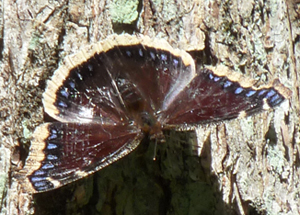 Sunday started out in a very spring-like manner and just kept getting warmer and sunnier all day. In the afternoon, Deborah and I took some of the just arrived daylight savings time to go down to the nearby Rock Furnace Trail. There were several “signs of spring” that we wanted to look for.
Sunday started out in a very spring-like manner and just kept getting warmer and sunnier all day. In the afternoon, Deborah and I took some of the just arrived daylight savings time to go down to the nearby Rock Furnace Trail. There were several “signs of spring” that we wanted to look for.
A couple of hundred yards down the trail from the parking area is the McInerney #6 gas well. Just opposite of the well is a tall, concave, south-facing shale cliff that acts as a natural solar collector. Spring wildflowers bloom around this warming rock face weeks before they show up anywhere else in the area (see this previous March blog entry). Since my crocuses had started to bloom around my house I thought that there was a chance that the first wild, yellow blooms of spring, colt’s foot (Tussilago farfara), might be up. I poked through the dry stems and leaves at the base of the cliff but didn’t find any flowers. Maybe they’ll be up next week! .
There is also a shallow ditch between the trail and the cliff that drains very poorly (if at all). The clear water of this ditch is a great place to see chains of amphibian eggs that the local frogs, toads, and salamanders deposit and fertilize on warm nights in March and April. These fertilized eggs and their aquatic tadpoles race to complete their development before the water in the ditch evaporates. A dry spring often means the loss of an entire amphibian generation! We have had a good snow season this year and the ditch is full of water. No amphibian eggs yet, though.
The flower buds on the red maples and silver maples around my house have begun to swell. As the buds expand they brush these trees with a faint reddish glow. You can look at the ridges all over Western Pennsylvania at this time of year and really appreciate how abundant these once relatively uncommon tree species are. Up to 30% of the trees in our surrounding forests are red maples. Surveys of Pennsylvania’s primal forest, though, put them originally at less than 1% of the native species. These fast growing trees have filled in our forests after the extensive clear cutting of the late Nineteenth and early Twentieth Centuries.
I check the ridges running high above the converging runs and creeks but see no reddish blush yet. Cooler temperatures out here away from town must be slowing the budding down.
Hiking on the trail down into the ravine (thinking all the while about the long hike back up!) I look for the eastern phoebe who has for the past five years staked out the lower section of this trail for his mating territory. He keeps a close eye on anyone passing through the area chirping his eponymous “phoebe” song as he follows you down the trail, perching on high tree branches and flicking his tail impatiently. There are no birds along the trail, though. No phoebe yet. I am sure, though, that he is making his way back here from his Central American winter digs.
So, no colt’s foot, no amphibian eggs, no red maple buds, no phoebes. But, it sure feels like spring! Deborah did spot a couple of hopeful signs on our walk. She saw two mourning cloak butterflies down near the junction of the Rock Furnace and Roaring Run trails (see her picture above). Mourning cloaks overwinter as an adults and are typically the first butterflies seen in the spring. She also spotted a comma butterfly near the parking are end of the Rock Furnace trail.So the insects are waking up!
We ran into Rob and Michele toward the end of our walk and they reported that they saw their first chipmunk of the spring! Hibernating mammals are waking up, too!
Keep watching for spring, everyone! The Worm Moon is coming, and the robins are back in Apollo (at last!).
